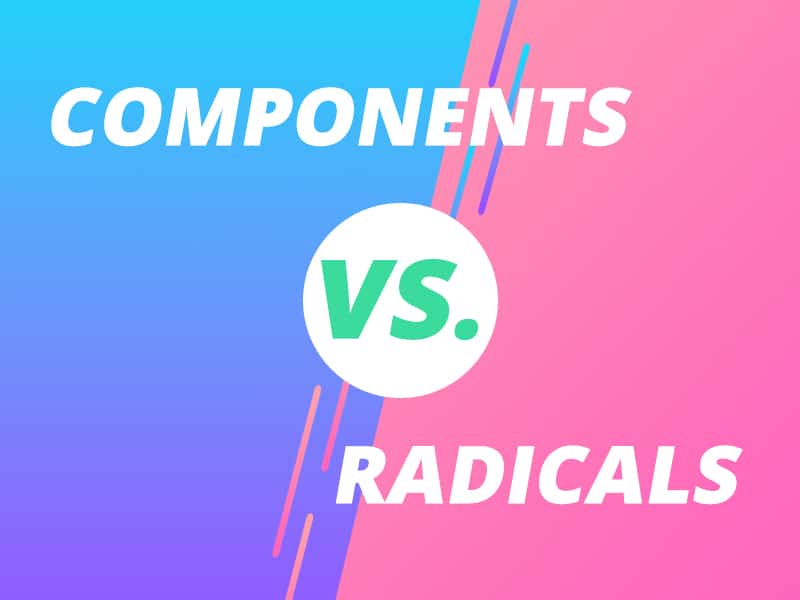As Chinese learners, we are always looking for tools and hacks to increase our Chinese learning efficiency. We want to learn as fast and as efficiently as possible. So today, we’re putting two techniques to the test: Chinese character components vs. radicals. How do they stack up? Which should you choose to learn?
While Chinese radicals have interesting use, Chinese components bring more benefits to your learning. Let’s explore so we can prove that to you!

What are Chinese components?
First, a little refresher on what Chinese components are. Components are like atoms that form a chemical element, but instead, they make up a Chinese character. It’s a natural law, almost. Every Chinese character is made of components that are the building blocks of any character.
Three types of character components
Experts have identified three forms of components with different attributes. These attributes are where the magic truly happens. They give you clues about the whole character, the big picture.
The three categories of components are:
- Meaning component, which indicates the general meaning of a character. (形旁)
- The phonetic / Sound component shows the sound, but the tone can differ. (声旁)
- The graphic/empty component helps you visually recognize and write a character.
Spot a meaning component in a character? You’ll have a pretty good idea of what the character could mean, or at the very least, in what semantic field this character is. A sound component will help discover and remember character pronunciations. A graphic component is a powerful hint to writing a character. Excellent tools to approach a character, I’d say.
How many Chinese components?
Do you think every Chinese remembers all the Chinese characters that exist? Of course, they recognize many of them, but not all of them. They have other solutions, much more practical. For instance, they use character components to help them identify more characters than they know. No wonder. You’ll have trouble believing me if I tell you the sheer amount to learn to almost understand all Chinese characters.
There are only about 200 key components! From over 50,000 Chinese characters, that’s a tremendous narrowing down. However, I believe you understand now why Chinese components are essential to learn. You’ll save a huge amount of time in your character learning by learning these key components. Moreover, even the most complicated characters are easy to approach when you can break them down into components.
Transform the way you read Chinese characters
When you know these components well, you will read Chinese characters entirely differently. As a result, you’ll first see the big picture and the overall character and then look for components (almost immediately and unconsciously). As a result, you’ll have changed how you read Chinese characters. And from there, you’ll learn Chinese characters faster and will be able to identify their meaning or pronunciation or close.
Chinese components sound great! Where can you learn them?
Why, right here, of course!
Explore and learn more about Chinese components here: https://ninchanese.com/blog/2020/03/12/chinese-components-radicals-chinese-characters. In addition, you will find a list of the key Chinese components to know here.
Practice and Learn components: 
Okay, I’m sold, but what about radicals? Aren’t those a great way to learn characters too? What’s the difference between Chinese components and Chinese radicals?
Radical VS Components
What are Chinese radicals?
Radicals are tremendously well-known. They started as a research project to categorize Chinese characters as early as the 2nd century AD. That was such a revolution that everyone in China then adopted them. Now, the use of radicals has evolved.
Use Chinese radicals to look up words in a dictionary.
Chinese radicals are still used to finding characters in the Chinese dictionary on paper. They are the graphical component you use to look up a Chinese character in a paper dictionary. That’s because radicals traditionally group characters in these dictionaries. It’s a great and practical invention.
But the radical list was made by hand, or I would say by mental force, so that’s too much to process. At the time, what they did was incredible and worked for a dictionary, but the list is also incomplete and not the best to learn the Chinese characters.
As we’ve seen, character components work differently. Nevertheless, they are essential to understand how characters are made, and now the list is well defined. We can definitively call radicals the grandfathers of the components.
If radicals are so limited, how come everyone seems to talk about them and use them to teach Chinese?
The answer is simple; in the ’80s and before, you needed to learn the radicals to use a Chinese dictionary. It was the only tool available at this time. So radicals are taught early in Chinese learning, as it is a great tool. Later, when we learn components, people are often confused. Because radicals share some similarities with components, they mix things up. They think components are radicals, and as sometimes radicals are components, all radicals are components. But components are not Chinese radicals.
Firstly, radicals were primarily selected for their visual aspect. They are only graphic components of Chinese characters, and that’s it. These graphic elements are used as the head of sections to categorize characters visually. Components are much more. As you saw, they bring you information on a Chinese character’s meaning or pronunciation. They can also be graphic components.
Secondly, there can be more than one component in a Chinese character. There usually is. But not so with radicals. A great example is when you hear someone say, this character has two radicals! But that is impossible; radicals are unique in a character to categorize them. So they would have been correct if they said there’s two components and one radical. That’s why focusing on Chinese components is a lot more effective.
So, as you can see, in the match Components vs. Radicals, Components win hands-down!
Are you excited to learn them? There’s a whole course dedicated to Chinese components awaiting you on Ninchanese!
What about strokes? Mnemonics? How useful are they for learning Chinese?
Chinese Character Strokes vs. Components
When people start learning Chinese, they are often interested in learning how to write them. It’s a pretty nice way to get accustomed to characters. It also helps to see them differently and learn to decompose them. Characters are not scribbles anymore but start to make sense as you see all the strokes that compose a character. However, from a learning point of view, the details are too great. You can’t remember how many strokes all 50 000 Chinese characters have or the 5,000 to 8,000 you need to reach fluency. It’s nearly impossible.
If you’ve followed our logical demonstration, it makes sense to learn to write the strokes of the 200 key components. After that, it’s only a matter of building the character and drawing the components in the right place and in the correct size.
Curious to see the strokes in Chinese characters?
You can view stroke animations for every character on Ninchanese. Just look up a word in our dictionary. They’ll show you all the strokes and which stroke order you should write the Chinese character. You’ll also see the character broken down by components!
Mnemonics VS Component
Mnemonics are an excellent technique for remembering things. They work pretty well but require making a story with concrete things. These are great for simple characters, but it’s hard to make a story for each character as the strokes become more complicated.
But let’s suppose you know the components already (and soon, you will, thanks to this course on Ninchanese). Then, if you start making a story using components interacting with each other fused with the meaning of the character, it’s golden. You’ll never forget them.
One of my favorite mnemonics is remembering how to write the character cat: 猫. It contains three parts.
A cat is an animal, so on the left of the character 猫, you’ll find the meaning component for animals (犭).
Then comes storytime, as the other two on the right are empty components. Let’s imagine we’re talking about an outdoor cat. A cat needs grass 艹) and a field (田) in which to roam. Meowsome way to remember how to write 猫.
As a result, the match can be considered null. That’s because combined, mnemonics and components are pretty helpful together! So use mnemonics if you want, and mainly use them to make up stories about character components! An excellent place to start building your mnemonics is this list of the key components. Click on any component, and you’ll get a detailed description of it, how it’s used and in which Chinese characters you can find it.
Components win the match!
So, in conclusion, we hope you now understand the difference between radicals and components more clearly. By now, you should see the benefits Chinese components can bring to your Chinese learning. They are hands-on and the best way to boost your Chinese characters. There are only about 200 to learn, and they bring you great clues to understand Chinese characters!
– They help you understand a character’s meaning.
– They help you determine a character’s pronunciation.
– They’re a great visual aid to recognize and handwrite a character.
Don’t miss out on the opportunity to learn them with us. Our exclusive course has a complete list of components to learn. We categorize all the components based on their feature (phonetics, meanings…), and they are topologically sorted, so you know the most useful first. So what are you waiting for? It’s here already. Have fun :D!
The Nincha Team




